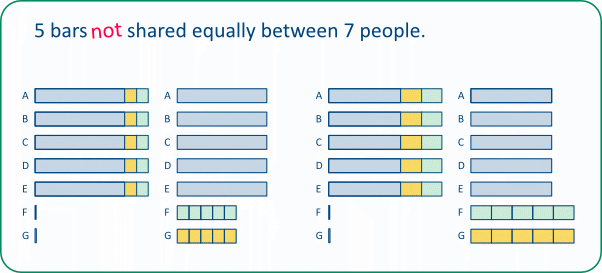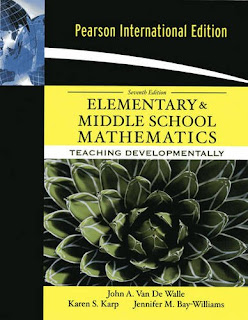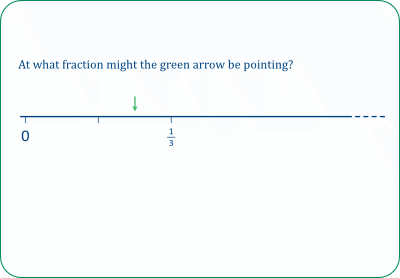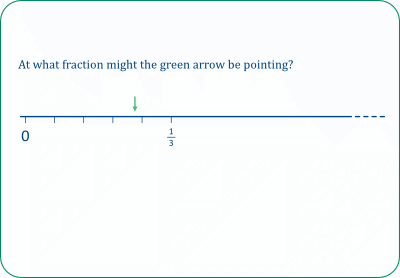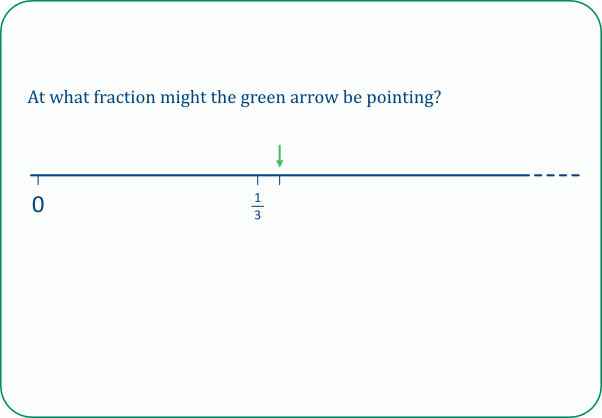Another interlude. Here I look at a paper by Gregg and Gregg on the division of a fraction by a fraction. This is not as fundamental as the issue of connecting fractions with division, as in the discussion about statement like 3÷4 = ¾, in Theme D13 (Parts of a whole and sharing).
The paper is concerned with the rule that allows us to change a division into a multiplication, as in the statement below. Gregg&Gregg consider two aspects of division (measurement, or quotitive division, and sharing, or partitive division) and present contexts to help students (in their case student teachers) make sense of these forms of division when they involve fractions. Their aim is to help the students see why we can transform a division involving fractions into a multiplication.
The paper is interesting on several counts. One concerns problem strings: they present some nicely designed ones, but how effective might they be? Second, and more fundamental, how easy is it to devise situations that help students see why a formal transformation like the one above is valid? And third, which aspect of division might be more salient when it comes to this particular transformation?
In the introduction to the paper we are presented with this task:
The authors claim that their students will often solve this by writing ½ × ⁴⁄₃ = ⁴⁄₆ = ⅔, on the basis that "...it's really ½ ÷ ¾, but I flipped the second fraction and multiplied". They go on to say that students struggle to explain why this 'flip-and-multiply' procedure works.
It is perhaps not surprising that their students generally don't have a good explanation for the 'flip-and-multiply' rule. On the other hand, I am surprised that they seem so readily able to construe the structure of the task in terms of a formal expression: ½ ÷ ¾. This, it seems to me, is quite impressive. I would have expected a more grounded approach to have been more common, such as this:
Half the floors in three-quarters of an hour means ⅙ of the floor in one quarter of an hour, which means ⁴⁄₆ or ⅔ of the floors in an hour.
This of course raises the issue, how readily does a grounded approach lead to a more formal understanding?
Division as measurement (quotitive division)
The paper continues with a look at tasks that tease-out division as measurement (though this is left implicit for quite a while). This is one of the problem strings they use with their students:
This is nicely sequenced, but I do wonder, as students work their way through so many tasks, do they become aware of the underlying structure, or are their senses dulled by so much information, rather like the frog in the slowly heating saucepan of water? Notice, too, that the string doesn't take us very far. One of the fractions is always ½, when the eventual goal is something more generic, like ¾ ÷ ⅔. Even if students can't yet resolve such a more challenging version, would it not give them a sense of where they need to go?
An alternative to presenting a fairly long problem string, like the one above, might be to start with the last problem in the string (the place you want students to get to) and then, if students struggle, ask them, individually or as a class, to come up with a more intuitable variant, by keeping the wording but changing the numbers.
[We can represent ¾ ÷ ⅔ as in the diagram below. Division as measurement amounts to asking how many times does ⅔ go into ¾? We can see that it fits once, with a light-green-bit left over. So the question becomes, what fraction of the dark green region is the light green region? It might not be immediately obvious but this turns out to be ⅛ - the light green region is one 12th of the original strip and the dark green region is eight 12ths of the original strip. So ¾ ÷ ⅔ = 1⅛. But how much light does this throw light on the 'flip-and-multiply' rule?]
[A careful scrutiny of the above diagram, in all its detail, might allow us to be confident about the answer, and to see how we could construct a similar diagram for another pair of fractions. As such, the diagram can be empowering. However, to get more insight into the actual 'flip-and-multiply' rule, in the case where division is interpreted as measurement, it might be helpful to consider a less grounded, more general approach:
- Imagine dividing something by a fraction 1/n. From a measurement point of view, the larger n is, the smaller 1/n will be and the more times it will fit into the dividend, D (where D is any rational number, whole or fractional). To be precise, 1/n will fit into 1 n times, and so it will fit into D, Dn times. So dividing by 1/n is the same as multiplying by n.
- Now, if we were to divide by m/n, which is m times as large as 1/n, our new fraction will fit into the dividend, D, 1/m times as often. So D ÷ m/n = (D × n) ÷ m = D × n/m.
The general form of the above argument might make it is inaccessible to some pupils. On the other hand some (older?) pupils might find it to be illuminating through its very lack of detail. Would the argument work as well if we replaced m/n by ⅔ and D by ¾?]
Returning to the above problem string used by Gregg&Gregg, the notion that these tasks can be thought of as division is not raised with their students until they have worked through two more strings of tasks. One of these involves fractions with the same denominator and that is where the work is heading: students experience that a (still rather simple) division like ¾ ÷ ⅓ can be solved by converting the fractions into 12ths, giving us ⁹⁄₁₂ ÷ ⁴⁄₁₂ which is 9 ÷ 4, which is 2¼. This is a nice grounded approach, but does it throw light on the 'flip-and-multiply' rule? My sense is, not much, since the fractions in their original form are no longer there!
Division as sharing (partitive division)
Towards the end of the paper, Gregg&Gregg look at division as sharing. At first glance, this might seem rather odd - how does one share something into a fractional number of groups?! They use a rather nice scenario of cakes and containers to do this.
They start by sharing their (fractional amount of) cake into a whole number of containers, as in the examples below. This is easy enough to understand and to construe as involving division. [Strangely, perhaps, sharing a fractional amount in this way is probably easier than sharing a whole amount, as in the classic 3 cakes for 4 people.]
Eventually they go from whole containers to fractions of a container, as in the examples below, where they end up with a quite general case involving the non-unit fractions ¾ and ⅔.

The crucial question here is, do we still see this as a division?
I think the scenario, and its formulation, works well, though some people might be
reluctant to accept it. And I do wonder whether we couldn't have modified a more orthodox sharing story, as here:
Three-quarters of a cake is shared equally between 2 people. What do they get each?
Three-quarters of a cake is the amount given to 2 people. What does one person get?
Three-quarters of a cake is the amount given to ⅔ of a person. What does one person get?
Three-quarters of a cake is ⅔ of the amount given to a person. What does the person get?
Van de Walle et al (2010) argue that partitive division includes not just sharing problems but also rate problems. As well as a problem like "24 apples to be shared with 4 friends", it includes a problem like "If you walk 12 miles in 3 hours, how many miles do you walk per hour?". In essence, partitive division problems ask, How much is one? (ibid, p321)
Let's return to the Gregg&Gregg formulation, in particular their Q3 (above):
I have ¾ of a cake. It fills up exactly ⅔ of a container.
If we now consider ⅓ of a container, rather than ⅔, and then consider a whole container, it is fairly easy to see that we can get to the answer by dividing by 2 and then multiplying by 3. Gregg&Gregg express this as follows:
The steps in this sequence of equations are not trivial, but, by relating them to the cake scenario, I think they show in a fairly grounded way that dividing by a fraction is equivalent to multiplying by its (multiplicative) inverse.
This is an interesting outcome: though the sharing view of division by a fraction is perhaps less 'natural' than the measurement view, in that we have to accept a somewhat contrived formulation of sharing, it provides us with a quite well grounded representation of the 'flip-and-multiply' rule.
PS: We can of course justify the 'flip-and-multiply' rule in a formal way. In the case of our division expression ¾ ÷ ⅔, we could, for example, multiply both fractions by ³⁄₂. This doesn't change the value of the expression but transforms it into (¾ × ³⁄₂)÷1, or just ¾ × ³⁄₂.
















